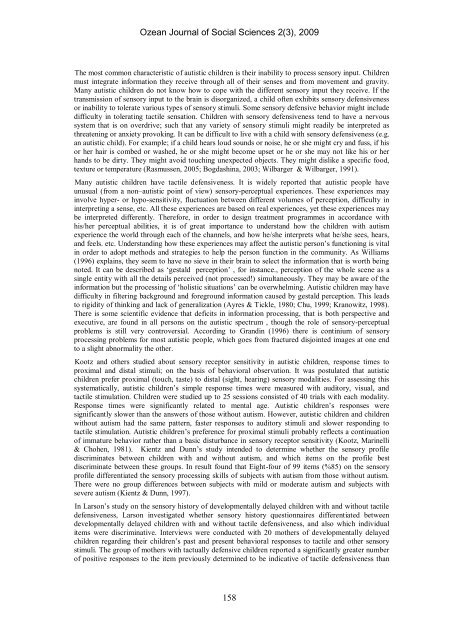Download complate issue - Ozean Publications
Download complate issue - Ozean Publications
Download complate issue - Ozean Publications
- No tags were found...
Create successful ePaper yourself
Turn your PDF publications into a flip-book with our unique Google optimized e-Paper software.
<strong>Ozean</strong> Journal of Social Sciences 2(3), 2009The most common characteristic of autistic children is their inability to process sensory input. Childrenmust integrate information they receive through all of their senses and from movement and gravity.Many autistic children do not know how to cope with the different sensory input they receive. If thetransmission of sensory input to the brain is disorganized, a child often exhibits sensory defensivenessor inability to tolerate various types of sensory stimuli. Some sensory defensive behavior might includedifficulty in tolerating tactile sensation. Children with sensory defensiveness tend to have a nervoussystem that is on overdrive; such that any variety of sensory stimuli might readily be interpreted asthreatening or anxiety provoking. It can be difficult to live with a child with sensory defensiveness (e.g.an autistic child). For example; if a child hears loud sounds or noise, he or she might cry and fuss, if hisor her hair is combed or washed, he or she might become upset or he or she may not like his or herhands to be dirty. They might avoid touching unexpected objects. They might dislike a specific food,texture or temperature (Rasmussen, 2005; Bogdashina, 2003; Wilbarger & Wilbarger, 1991).Many autistic children have tactile defensiveness. It is widely reported that autistic people haveunusual (from a non–autistic point of view) sensory-perceptual experiences. These experiences mayinvolve hyper- or hypo-sensitivity, fluctuation between different volumes of perception, difficulty ininterpreting a sense, etc. All these experiences are based on real experiences, yet these experiences maybe interpreted differently. Therefore, in order to design treatment programmes in accordance withhis/her perceptual abilities, it is of great importance to understand how the children with autismexperience the world through each of the channels, and how he/she interprets what he/she sees, hears,and feels. etc. Understanding how these experiences may affect the autistic person‟s functioning is vitalin order to adopt methods and strategies to help the person function in the community. As Williams(1996) explains, they seem to have no sieve in their brain to select the information that is worth beingnoted. It can be described as „gestald perception‟ , for instance., perception of the whole scene as asingle entity with all the details perceived (not processed!) simultaneously. They may be aware of theinformation but the processing of „holistic situations‟ can be overwhelming. Autistic children may havedifficulty in filtering background and foreground information caused by gestald perception. This leadsto rigidity of thinking and lack of generalization (Ayres & Tickle, 1980; Chu, 1999; Kranowitz, 1998).There is some scientific evidence that deficits in information processing, that is both perspective andexecutive, are found in all persons on the autistic spectrum , though the role of sensory-perceptualproblems is still very controversial. According to Grandin (1996) there is continium of sensoryprocessing problems for most autistic people, which goes from fractured disjointed images at one endto a slight abnormality the other.Kootz and others studied about sensory receptor sensitivity in autistic children, response times toproximal and distal stimuli; on the basis of behavioral observation. It was postulated that autisticchildren prefer proximal (touch, taste) to distal (sight, hearing) sensory modalities. For assessing thissystematically, autistic children‟s simple response times were measured with auditory, visual, andtactile stimulation. Children were studied up to 25 sessions consisted of 40 trials with each modality.Response times were significantly related to mental age. Autistic children‟s responses weresignificantly slower than the answers of those without autism. However, autistic children and childrenwithout autism had the same pattern, faster responses to auditory stimuli and slower responding totactile stimulation. Autistic children‟s preference for proximal stimuli probably reflects a continuationof immature behavior rather than a basic disturbance in sensory receptor sensitivity (Kootz, Marinelli& Chohen, 1981). Kientz and Dunn‟s study intended to determine whether the sensory profilediscriminates between children with and without autism, and which items on the profile bestdiscriminate between these groups. In result found that Eight-four of 99 items (%85) on the sensoryprofile differentiated the sensory processing skills of subjects with autism from those without autism.There were no group differences between subjects with mild or moderate autism and subjects withsevere autism (Kientz & Dunn, 1997).In Larson‟s study on the sensory history of developmentally delayed children with and without tactiledefensiveness, Larson investigated whether sensory history questionnaires differentiated betweendevelopmentally delayed children with and without tactile defensiveness, and also which individualitems were discriminative. Interviews were conducted with 20 mothers of developmentally delayedchildren regarding their children‟s past and present behavioral responses to tactile and other sensorystimuli. The group of mothers with tactually defensive children reported a significantly greater numberof positive responses to the item previously determined to be indicative of tactile defensiveness than158
















